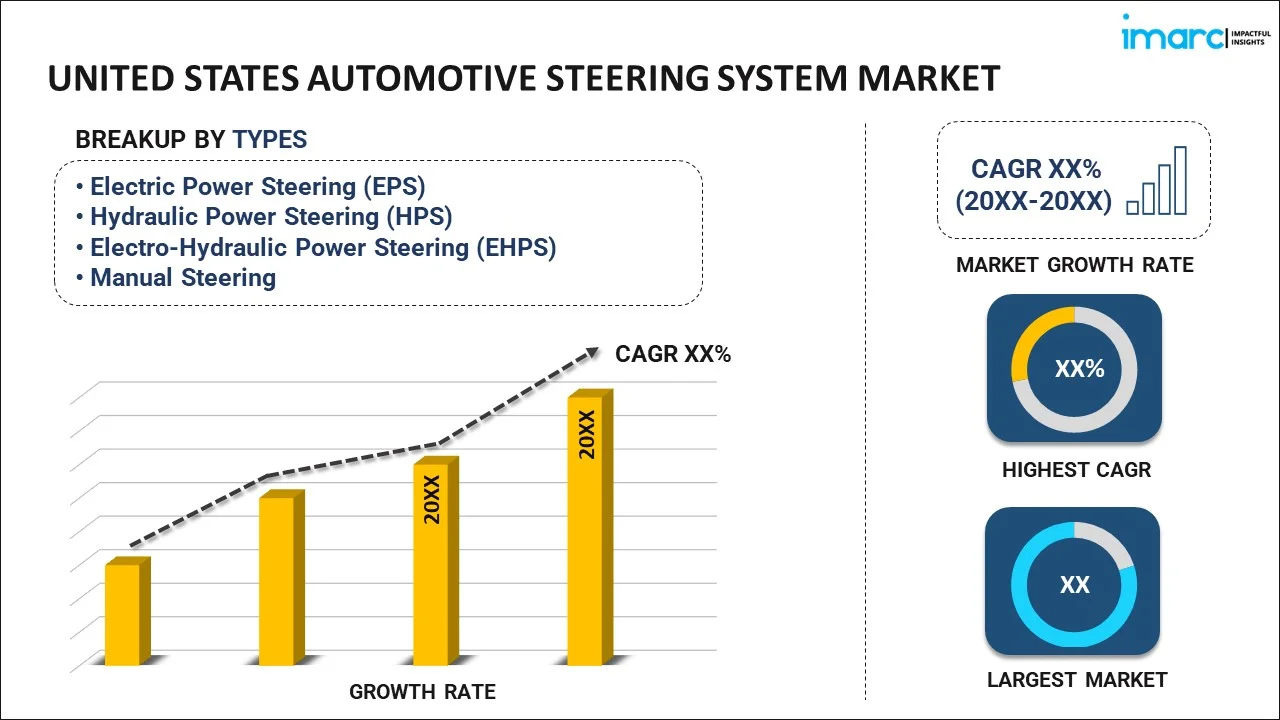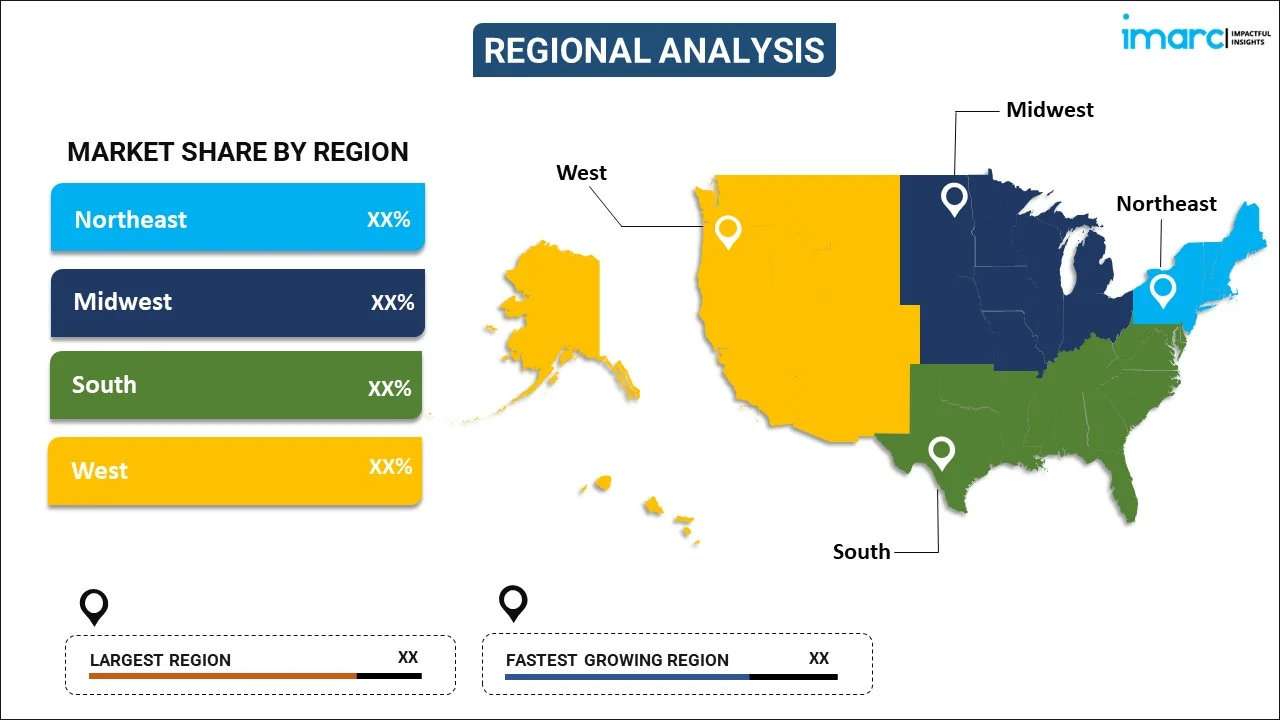
United States Automotive Steering System Market Report by Type (Electric Power Steering (EPS), Hydraulic Power Steering (HPS), Electro-Hydraulic Power Steering (EHPS), Manual Steering), Component (Steering Column, Steering Wheel Speed Sensors, Electric Motors, Hydraulic Pumps, and Others), Vehicle Type (Passenger Cars, Light Commercial Vehicles, Heavy Commercial Vehicles), and Region 2025-2033
Market Overview:
United States automotive steering system market size is projected to exhibit a growth rate (CAGR) of 2.95% during 2025-2033. The increasing development and testing of autonomous vehicles, which often involve advanced steering systems that are capable of handling various driving scenarios, is driving the market.
|
Report Attribute
|
Key Statistics
|
|---|---|
|
Base Year
|
2024 |
|
Forecast Years
|
2025-2033 |
|
Historical Years
|
2019-2024
|
| Market Growth Rate (2025-2033) | 2.95% |
The automotive steering system is a critical component that enables the driver to control the direction of a vehicle. It consists of various interconnected parts that work together to translate the driver's input into the desired movement of the wheels. The primary types of steering systems include rack-and-pinion, recirculating ball, and power steering. In a rack-and-pinion system, a pinion gear engages with a toothed rack to facilitate smooth and precise steering. Recirculating ball systems use a worm gear mechanism. Power steering, whether hydraulic or electric, assists the driver by reducing the effort required to turn the steering wheel. The steering system enhances vehicle maneuverability and responsiveness, contributing to overall driving safety and comfort. Advanced technologies, such as electronic steering systems, continue to evolve, offering improved efficiency and adaptability to varying driving conditions. A well-functioning steering system is vital for the overall control and stability of an automobile.
United States Automotive Steering System Market Trends:
The automotive steering system market in the United States is experiencing robust growth, driven by a confluence of factors that collectively shape the industry's trajectory. Primarily, the increasing demand for enhanced vehicle safety features has propelled advancements in steering technology. As consumers prioritize safety, automotive manufacturers are compelled to integrate innovative steering systems that offer superior control and responsiveness. Furthermore, the rising trend toward autonomous vehicles has fueled the demand for sophisticated steering systems capable of seamlessly integrating with autonomous driving technologies. Consequently, steering systems are evolving to not only meet traditional safety standards but also to align with the demands of futuristic self-driving vehicles. Moreover, stringent government regulations emphasizing fuel efficiency and emission reduction have spurred a shift towards electric power steering systems. The transition from traditional hydraulic systems to electrically assisted steering not only aligns with environmental concerns but also enhances overall vehicle efficiency. Additionally, the automotive industry's continual quest for weight reduction and fuel economy, which has increased the adoption of advanced materials and design concepts in steering system components, is expected to drive the market in the United States during the forecast period.
United States Automotive Steering System Market Segmentation:
IMARC Group provides an analysis of the key trends in each segment of the market, along with forecasts at the country level for 2025-2033. Our report has categorized the market based on type, component, and vehicle type.
Type Insights:

- Electric Power Steering (EPS)
- Hydraulic Power Steering (HPS)
- Electro-Hydraulic Power Steering (EHPS)
- Manual Steering
The report has provided a detailed breakup and analysis of the market based on the type. This includes electric power steering (EPS), hydraulic power steering (HPS), electro-hydraulic power steering (EHPS), and manual steering.
Component Insights:
- Steering Column
- Steering Wheel Speed Sensors
- Electric Motors
- Hydraulic Pumps
- Others
A detailed breakup and analysis of the market based on the component have also been provided in the report. This includes steering column, steering wheel speed sensors, electric motors, hydraulic pumps, and others.
Vehicle Type Insights:
- Passenger Cars
- Light Commercial Vehicles
- Heavy Commercial Vehicles
The report has provided a detailed breakup and analysis of the market based on the vehicle type. This includes passenger cars, light commercial vehicles, and heavy commercial vehicles.
Regional Insights:

- Northeast
- Midwest
- South
- West
The report has also provided a comprehensive analysis of all the major regional markets, which include the Northeast, Midwest, South, and West.
Competitive Landscape:
The market research report has also provided a comprehensive analysis of the competitive landscape in the market. Competitive analysis such as market structure, key player positioning, top winning strategies, competitive dashboard, and company evaluation quadrant has been covered in the report. Also, detailed profiles of all major companies have been provided.
United States Automotive Steering System Market Report Coverage:
| Report Features | Details |
|---|---|
| Base Year of the Analysis | 2024 |
| Historical Period | 2019-2024 |
| Forecast Period | 2025-2033 |
| Units | Billion USD |
| Scope of the Report | Exploration of Historical and Forecast Trends, Industry Catalysts and Challenges, Segment-Wise Historical and Predictive Market Assessment:
|
| Types Covered | Electric Power Steering (EPS), Hydraulic Power Steering (HPS), Electro-Hydraulic Power Steering (EHPS), Manual Steering |
| Components Covered | Steering Column, Steering Wheel Speed Sensors, Electric Motors, Hydraulic Pumps, Others |
| Vehicle Types Covered | Passenger Cars, Light Commercial Vehicles, Heavy Commercial Vehicles |
| Regions Covered | Northeast, Midwest, South, West |
| Customization Scope | 10% Free Customization |
| Post-Sale Analyst Support | 10-12 Weeks |
| Delivery Format | PDF and Excel through Email (We can also provide the editable version of the report in PPT/Word format on special request) |
Key Questions Answered in This Report:
- How has the United States automotive steering system market performed so far and how will it perform in the coming years?
- What has been the impact of COVID-19 on the United States automotive steering system market?
- What is the breakup of the United States automotive steering system market on the basis of type?
- What is the breakup of the United States automotive steering system market on the basis of component?
- What is the breakup of the United States automotive steering system market on the basis of vehicle type?
- What are the various stages in the value chain of the United States automotive steering system market?
- What are the key driving factors and challenges in the United States automotive steering system?
- What is the structure of the United States automotive steering system market and who are the key players?
- What is the degree of competition in the United States automotive steering system market?
Key Benefits for Stakeholders:
- IMARC’s industry report offers a comprehensive quantitative analysis of various market segments, historical and current market trends, market forecasts, and dynamics of the United States automotive steering system market from 2019-2033.
- The research report provides the latest information on the market drivers, challenges, and opportunities in the United States automotive steering system market.
- Porter's five forces analysis assist stakeholders in assessing the impact of new entrants, competitive rivalry, supplier power, buyer power, and the threat of substitution. It helps stakeholders to analyze the level of competition within the United States automotive steering system industry and its attractiveness.
- A competitive landscape allows stakeholders to understand their competitive environment and provides an insight into the current positions of key players in the market.
Need more help?
- Speak to our experienced analysts for insights on the current market scenarios.
- Include additional segments and countries to customize the report as per your requirement.
- Gain an unparalleled competitive advantage in your domain by understanding how to utilize the report and positively impacting your operations and revenue.
- For further assistance, please connect with our analysts.
 Inquire Before Buying
Inquire Before Buying
 Speak to an Analyst
Speak to an Analyst
 Request Brochure
Request Brochure
 Request Customization
Request Customization




.webp)




.webp)












